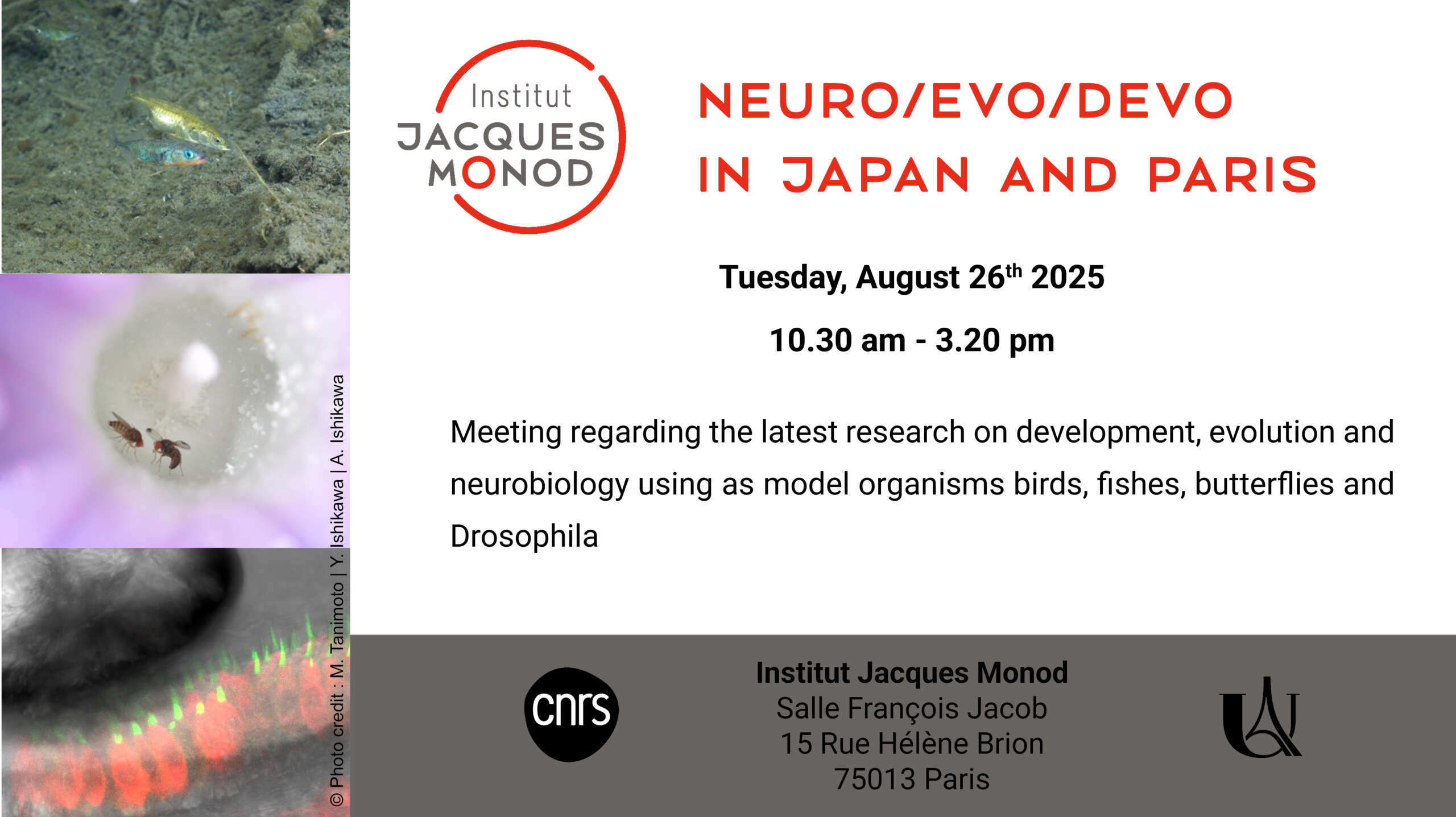
- This event has passed.
Neuro/Evo/Devo in Japan and Paris

Neuro/evo/devo in Japan and Paris
Meeting regarding the latest research on development, evolution and neurobiology using as model organisms birds, fishes, butterflies and Drosophila
Organised by Virginie Courtier (contact)
Program
10:30: Welcome coffee
11:00 – 11:05: Introduction (V. COURTIER-ORGOGOZO)
11:05 – 11:25: A key pleiotropic gene underlying the diversification of seasonal reproduction in sticklebacks (Asano ISHIKAWA)
11:25 – 11:45: Developmental bases of trends and variation in color patterns (Marie MANCEAU)
11:45 – 12:05: Drosophila pigmentation: a model to study the impact of environmental and natural genetic variations and the role of developmental constraints (Jean-Michel GIBERT)
12:05 – 14:00: Lunch
14:00 – 14:20: Evolution of Drosophila glue (Virginie COURTIER-ORGOGOZO)
14:20 – 14:40: How Fish Stay Upright: Neural Mechanisms of Head Tilt Sensing and Balance Control in Zebrafish (Masashi TANIMOTO)
14:40 – 15:00: From ecology to neural adaptation in flower-visiting Drosophila elegans (Yuki ISHIKAWA)
15:00 – 15:20: From ecological divergence to genetic architecture: what is driving sympatric speciation? (Violaine LLAURENS)
15:20: End of the meeting
Abstracts (alphabetical order of names)
Evolution of Drosophila glue
Virginie COURTIER-ORGOGOZO
At the end of the larval stage, Drosophila larvae produce a proteinaceous glue that allows the animal to adhere to a substrate for several days during metamorphosis. We are currently using Drosophila powerful genetic tools to identify the genes involved in glue adhesion and understand how they have changed during evolution so that the glue can stick to various substrates in diverse environments. We developed a new assay to quantify Drosophila glue adhesiveness and compared adhesion between different Drosophila melanogaster populations and Drosophila species. We identified one particular Drosophila species with highly adhesive glue. Furthermore, we also explore natural environments (rotten fruits, soil, etc.) to understand better this fascinating biomaterial that is Drosophila glue. Our ultimate goal is not only to better understand adaptation but also to develop new bioadhesives inspired from Drosophila glue.
Drosophila pigmentation: a model to study the impact of environmental and natural genetic variations and the role of developmental constraints
Jean-Michel GIBERT
Drosophila pigmentation is involved in many adaptive process such as thermoregulation or protection against UV, parasites or pathogens. Furthermore, in Drosophila melanogaster pigmentation is genetically variable and modulated by temperature during development. Using female abdominal pigmentation as a model, we analyzed the genetic bases of these phenomenon. We found that temperature modulates the expression of regulatory and effector genes involved in pigmentation, and, interestingly, that these genes carry variation modulating pigmentation in natural populations. In addition, we showed that a particular pigmentation pattern on the thorax is linked to developmental constraints, as it is shaped by flight muscle attachment sites.
A key pleiotropic gene underlying the diversification of seasonal reproduction in sticklebacks
Asano ISHIKAWA
Reproductive timing is a key life-history trait that affects fitness, with populations often undergoing diversification in reproductive patterns to adapt to varying seasonal environments. However, the molecular genetic mechanisms underlying differences in reproductive seasonality are not well understood. To address this, we use the three-spined stickleback (Gasterosteus aculeatus) as a model. While marine ecotypes of sticklebacks reproduce in early summer, freshwater ecotypes show significant variation in reproductive timing, with stream ecotypes at lower latitudes breeding almost year-round. Our study reveals that marine sticklebacks exhibit a photoperiodic response in gonad development, while this response is lost in stream ecotypes, which evolved independently in Japan and North America. Transcriptome analysis identified the thyroid stimulating hormone beta 2 (TSHβ2) gene as a key regulator of this response. Knocking out TSHβ2 in marine ecotypes led to earlier maturation under short photoperiods, similar to stream ecotypes in terms of behavior, body size, hormone levels, and brain transcriptome. Linkage mapping revealed that the loss of seasonality in stream ecotypes is due to convergent mutations in the TSHβ2 pathway—cis-regulatory in North America and trans-regulatory in Japan. Single-cell analysis detected a novel TSHβ2-expressing 2 pituitary cell cluster, and we observed increased TSHβ2 expression and chromatin accessibility under short-day conditions. These findings suggest that transcriptional and epigenetic mechanisms drive the evolution of reproductive seasonality in sticklebacks.
From ecology to neural adaptation in flower-visiting Drosophila elegans
Yuki ISHIKAWA
Flower-visiting behavior in insects is essential for plant reproduction and the stability of terrestrial ecosystems. Although insects have existed on Earth long before the evolution of flowering plants, they developed flower-visiting behavior in parallel with the adaptive radiation of angiosperms. However, the neural basis of this behavioral evolution remains unclear.
To investigate this, we studied Drosophila elegans, a flower-breeding species closely related to the non-flower-visiting model organism D. melanogaster. D. elegans has evolved a flower-dependent life cycle and exhibits pronounced flower-visiting behavior in its natural habitat. Field observations revealed that it relies on specific flower species for both breeding and feeding. These ecological preferences suggest behavioral and neural adaptations that enable recognition of appropriate flowers. Behavioral assays showed that visual cues—especially color—are crucial for flower recognition. Comparative analyses suggest that its visual system is adapted to detect relevant flower colors, and genome editing identified specific photoreceptor cells that are essential for this behavior.
In this talk, I will discuss how ecological specialization and neural adaptation have together contributed to the evolution of flower-visiting behavior in this species.
From ecological divergence to genetic architecture: what is driving sympatric speciation?
Violaine LLAURENS
Determining the evolutionary forces initiating and fuelling the speciation process is challenging, especially when population divergence occurs in sympatry. Sympatric speciation often involves complex interactions between ecological specialization generating divergent selection and the accumulation of genetic barriers to gene flow. Here we focus on a pair of sister-species of butterflies (M. achilles and M. helenor) observed in sympatry throughout the Amazonian basin, and sharing similar micro-habitat but diverging in the timing of male patrolling behaviour. Since M. helenor has a larger geographical range, we compared the temporal niche in sympatric and allopatric populations of this species and found a significant shift in patrolling hours, suggesting that the evolution of temporal niches might contribute to the speciation or reinforcement process. Using population genomics, we then reconstructed the history of speciation between these two species and investigated the heterogeneity in the level of genetic divergence throughout the genome. We found a very strong differentiation in the sexual chromosome (Z) as compared to the autosomes between species but not between populations within species. We then specifically tested for the effect of selection in such increased rate of evolution in the Z chromosomes and found significantly higher signals of positive selection in the Z vs. the autosomes in sympatric population, while such a signal was missing in the allopatric ones. Furthermore, by testing the association between the temporal niche and genomic variations across populations of M. helenor, we found significant signals on two loci within the Z-chromosome, including one non-coding region located between the circadian genes PDP1 and Period. Altogether, our results raise questions on the implication of the Z chromosome in ecological specialization and speciation in sympatry.
Developmental bases of trends and variation in color patterns
Marie MANCEAU
The color patterns that adorn animals’ coats exhibit extensive diversity linked to various ecological functions, but also display recurrences in geometry, orientation or body location. How processes of pattern formation shape such phenotypic trends remains a mystery. We surveyed plumage color patterns in poultry birds and passerine finches respectively displaying variation in striped pattern and color domain distribution, and identified conserved features that we linked to embryonic pre-patterns (i.e. putative embryonic skin regions outlined by the combinatory expression of few genetic markers). We showed that these pre-patterns are instructed by early developmental tissues, variation resulting from late dose-dependent mechanisms controlling stripe width, or pigmentation choices that mask or display skin domains. This work revealed that early conserved landmarks and molecular pathways are a major cause of phenotypic trends.
How Fish Stay Upright: Neural Mechanisms of Head Tilt Sensing and Balance Control in Zebrafish
Masashi TANIMOTO
Body equilibrium is vital for all living organisms. In vertebrates, vestibular signals from the inner ear play pivotal roles in maintaining balance. Larval zebrafish serve as an advantageous model since their transparent tissues facilitate live imaging of neural mechanisms during behavior. We developed an imaging system that simultaneously visualizes neural activity and behavior while controlling fish orientation. Using this approach, we revealed the neural mechanisms of head tilt sensing and posture control. I will share what fish study can tell us about vertebrate balance control.

